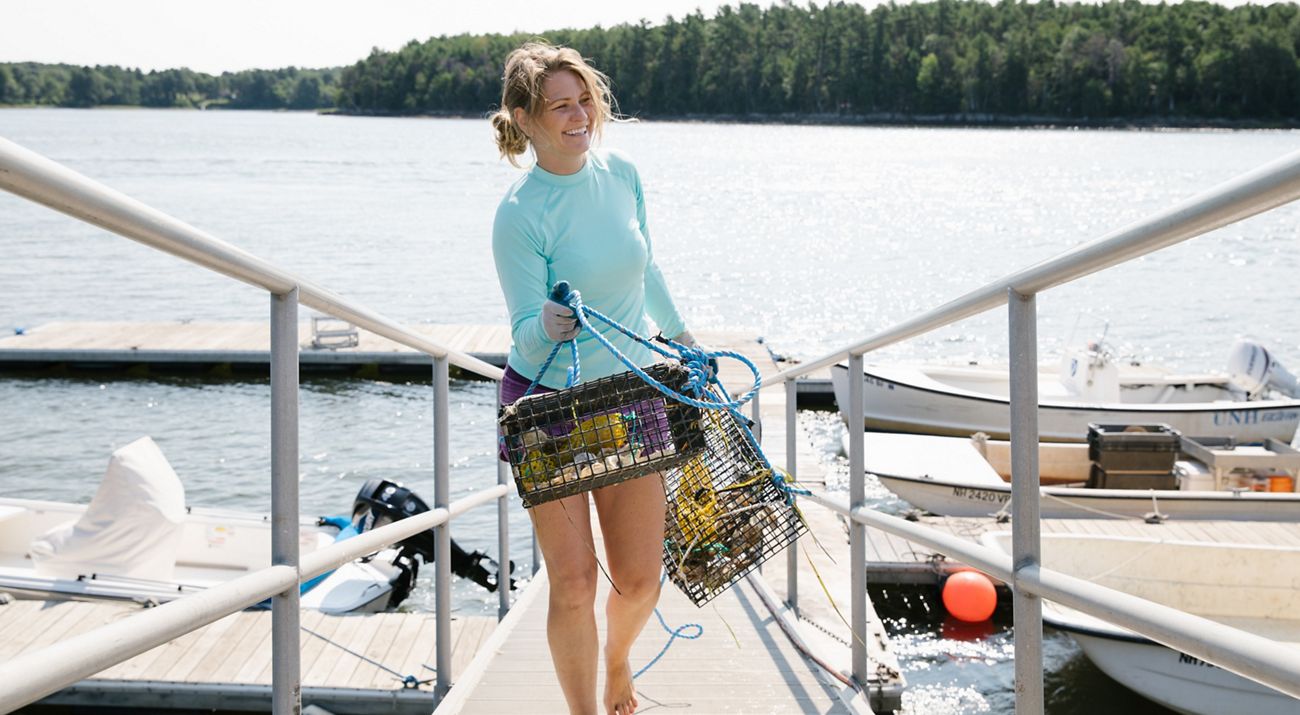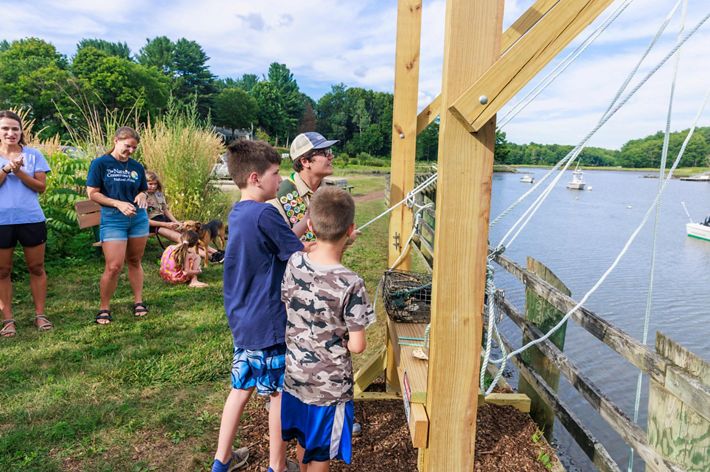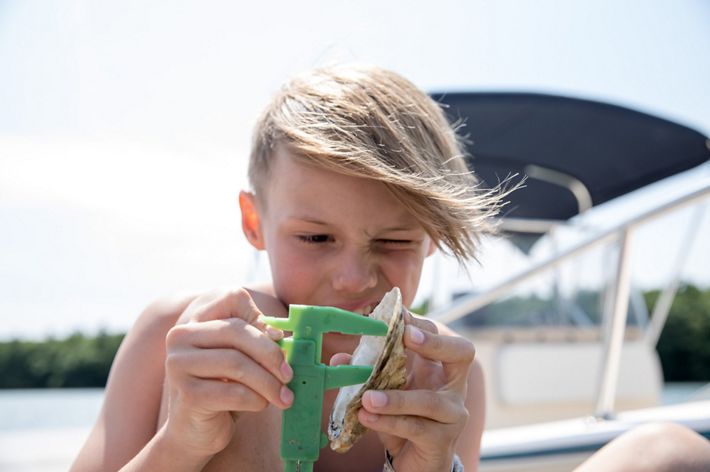Oyster Conservationist Volunteer
Great Bay, New Hampshire

Join us in restoring oysters to the Great Bay estuary with New Hampshire's Oyster Conservationist Program. Together with University of New Hampshire (UNH), The Nature Conservancy is leading efforts to rebuild historic oyster reefs. Local residents like you have been actively participating in the Oyster Conservationist Program since 2006 and have raised more than 327,000 oysters off their docks, moorings and boats for restoration.
What You Will Do
As an Oyster Conservationist, you'll be working from your dock, mooring or boat helping to raise baby oysters (called spat) in cages, checking on the health of the oysters, collecting data and more!
Get more details in the Qualifications tab (below).
Don't have water access? You can still participate! See the Community Oyster Gardens tab (also below).
Enrollment and Timeline
This opportunity will run for ten weeks during the summer, with applications accepted until June for each season. Sign up by reaching out to Kelsey Meyer-Rust and telling us a little more about yourself and how you would like to participate.
Get more details in the Timeline tab (below).
During this program, you will:
- Directly engage in oyster restoration efforts.
- Contribute to making a difference in your local estuary.
- Meet other like-minded people in our growing oyster community.
- Get motivated to be outside in nature/your backyard/water access.
- Experience a hands-on learning opportunity about the magnificent oyster!
- Enjoy a family-friendly activity.
How to Apply
To apply, please email our Coastal Conservation Coordinator, Kelsey Meyer-Rust.
Please reach out if you would like to learn more about the program. We value our volunteers and how they continually make a difference each year. The more oysters we can raise into healthy survivors, the faster we will "clean" Great Bay Estuary!
This will be a 10 week program from mid-July to mid-September. More details on dates and time schedules will be provided to those who get enrolled.
Oyster Conservationist qualifications:
- Local residents of southeastern New Hampshire with water access (dock, mooring, boat or other means of water access)
- Committed to helping improve the health of Great Bay and Piscataqua Estuary
Oyster Conservationist activities:
- Participate by raising oysters in a cage off their docks, moorings, boats or by other means of access to water for 10 weeks (mid July - mid September).
- Check on oysters once (briefly) per week for predators and fouling.
- Collect data on oyster size (to track growth at site) twice during summer (takes less than an hour).
- Say goodbye to oysters in mid-September as they are planted at restoration reef sites to they help filter the bay’s water.
- Communicate with Program Coordinator on any questions during their experience or help with checking on oysters while away on travel.
- (Optional) Attend the annual Oyster Conservationist Appreciation Event, meet other oyster parents, learn program results and celebrate another year of success!
Timeline
Now-June: Sign-up today to inquire about hosting a cage for the upcoming season or join us for our spat counting events.
Early June: We will contact and confirm our list of new and returning Oyster Conservationists participating this season (10 weeks).
Mid-July Oyster Cage Delivery: Young oysters will be delivered to you in a cage (20”x13”x6”) and secured to your dock/mooring/etc. Our cage set-up includes a 4'-5’ rope and float to keep the oysters slightly elevated off the bottom. Our Habitat Restoration Coordinator will provide a training session and answer any questions you have.
July-September Monitoring: Monitor oyster cages weekly for predators and health. Collect data on oyster growth twice during this 10-week period.
Mid-September Oyster Cage Pickup: Our Habitat Restoration Coordinator will collect oyster cages. The oysters will be moved to Jackson Estuarine Lab at UNH until ready for planting at the restoration site in the Piscataqua River.
Don't have water access? Join our Community Oyster Gardens!
You don't need private water access in order to participate in science and help Great Bay. To increase access and encourage more people in the Seacoast to get involved with oyster restoration, we've opened Community Oyster Gardens in partnership with local municipalities—including one at the Town Landing on the Oyster River in Durham. The idea of the oyster garden is that anyone can pull up the rope, open the cages, count the spat-on-shell and record the data.
The location includes everything you need: oyster cages on ropes, measuring tools and an online data sheet for community members to record the size of juvenile oysters. The location includes an innovative pulley system developed for TNC by Eagle Scout Ben Sietz. His design centers around physical accessibility, with double pulleys that significantly reduce the effort needed to raise oyster cages from the water and a low platform meant as a workspace for kids and people who use wheeled devices.
Cages will be available at the Community Oyster Garden from mid-July through mid-September. And stay tuned! We're working to open more gardens around the Seacoast.
Durham Community Oyster Garden
Durham Town Landing
Old Landing Road
Durham, New Hampshire 03824
Why should we care about oysters?
These simple bottom-living, reef-building and filter-feeding bivalves are in fact a very important species! Oysters have disappeared from estuaries along the Atlantic coastline mainly due to pollution, disease and over-harvest. Here in the Great Bay estuary, New Hampshire's oysters were once common enough to serve a critical role in filtering the bay’s water every couple days, removing plankton and excess nutrients from the water. Today, there are not enough oysters in the estuary to effectively provide this vital service, and the decline in filtering oysters has resulted in diminished ecological benefits for water quality and clarity, nitrogen control and fish production.
A single acre of healthy oyster reef can process up to a ton of harmful nitrogen each year! Today just over 100 acres exist, including nearly 40 acres restored since 2009 through efforts led by TNC and UNH. To help bring back a sustainable natural filtration system to the Great Bay and Piscataqua estuaries, we have added 4 million oysters with the help of the local community through the Oyster Conservationist (OC) Program.
Together with UNH, we are leading efforts to rebuild historic oyster reefs, but we need your help. Local residents like you have been actively participating in the OC Program since 2006 and have raised more than 327,000 oysters off their docks, moorings and boats for restoration!
Want to learn more about restoring oysters to Great Bay?
Check out more information about how we're restoring oysters and the role they play in securing the Great Bay water's ecosystem and health.

